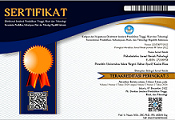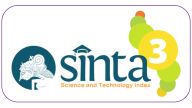Pengaruh Malu dan Religiusitas terhadap Self-Disclosure di Media Sosial Melalui Self-Control pada Muslim di Pekanbaru
Abstract
Islam mengajarkan pemeluknya untuk mempertimbangkan segala sesuatu sebelum bertindak, termasuk dalam mengungkapkan diri dalam ruang publik. Malu dan religiusitas yang ada pada umat muslim diharapkan mampu menjadi kontrol dalam mengekspresikan diri di media sosial. Penelitian ini bertujuan untuk mengetahui pengaruh malu dan religiusitas terhadap self-disclosure di media sosial melalui self-control pada muslim di Pekanbaru dalam sebuah model. Data diperoleh melalui skala Al-Haya’ untuk mengukur malu pada muslim, self-control scale, religiosity scale dan self-disclosure scale. Berdasarkan analisis SEM dari data 533 orang masyarakat pengguna media sosial di Kota Pekanbaru, diketahui bahwa model yang diajukan tidak fit dengan indeks kesesuaian model χ2 (5) = 214, p < 0.05; RMSEA = 0.000; SRMR = 0.000; CFI = 1.000; TLI = 1.000. Hasil ini menunjukkan bahwa tidak ada pengaruh self-control terhadap self-disclosure. Namun, diketahui bahwa terdapat pengaruh signifikan dari malu terhadap self-control dan terhadap self-disclosure secara langsung. Sementara religiusitas tidak berpengaruh secara langsung dan tidak langsung terhadap self-disclosure, meskipun memengaruhi self-control. Dengan demikian, orang yang memiliki malu dan religiusitas yang tinggi menunjukkan self-control yang lebih baik, namun tidak menentukan self-disclosure-nya di media sosial.
Keywords
Full Text:
PDFReferences
Albaran., Alan., B. (2013). The social media industries. Routledge, Taylor & Francis: New York
Al-Muqaddam, M. I. (2008). Fikih Malu: Menghiasi Hidup dengan Malu. Nakhlah Pustaka.
Amalia, R., Abidin, M, Z., & Riskasari, W. (2018). Hubungan antara Self-disclosure dan Religiusitas dengan Komitmen Pernikahan pada Istri Pelaut TNI-AL. Jurnal Psikologi POSEIDON. Vol. 01 No. 01. https://doi.org/10.30649/jpp.v1i1.23
Ancok, D & Suroso, F. N. (2011). Psikologi Islami. Pustaka Pelajar.
APJII. (2020). Laporan Survei Internet APJII 2019-2020. Asosiasi Penyelenggara Jasa Internet Indnesia, 2020, 1-146. Retrieved from https://apjii.or.id/survei
Arifin, H. H., & Milla, M. N. (2020). Adaptasi dan properti psikometrik skala kontrol diri ringkas versi Indonesia. Jurnal Psikologi Sosial, 18(2), 179–195. https://doi.org/10.7454/jps.2020.18
Bargh, J.A., McKenna, K.Y., & Fitzsimons, G.M. (2002). Can you see the real me? Activation and expression of the “true self” on the internet. Journal of Social Issues. Doi: 10.1111/1540-4560.00247
Basalamah, R.N. 2014. Al-Haya Sebagai Solusi Bagi Permasalahan Moral Bangsa. Jurnal Raushan Fikr. Vol. 3. No. 2. 101-113.
Baazeem, R., Benson, V., & Hand, C. (2018). Impact of Religiosity on Preserved Privacy on Social Media: Proposed Model of Self-disclosure Completed Research Paper Religion effect on the social media privacy View project Behavioural patterns in leisure markets View project. Twenty-Second Pacific Asia Conference on Information Systems, Japan 2018, July.
Baumeister, R. F., Vohs, K. D., & Tice, D. M. (2007). The Strength Model of Self-control. Current Directions in Psychological Science, 16 (6), 351-355. DOI: 10.1111/j.1467-8721.2007.00534.x
Bazarova, Natalya N., & Choi, Yoon, Hyung. (2014). Self-Disclosure in social media: Extending the functional approach to disclosure motivations and characteristics on social network sites. Journal of Communication. Volume 64, Issue 4, August 2014, Pages 635–657, https://doi.org/10.1111/jcom.12106
Brehm, S. S., Miller, R. S., Perlman, D., & Campbell, S. M. (2002). Intimate relationships 4th ed. New York, NY: Mcgraw-Hill.
Chairani, L., Cucuani, H., & Priyadi, S. (2021). Al-Haya’ Instrument Construction: Shame Measurement Based on the Islamic Concept. Jurnal Psikologi Islam dan Budaya, 4(1), 1–14.
Chen, F., Bollen, K. A., Paxton, P., Curran, P. J., & Kirby, J. B. (2001). Improper solutions in Structural Equation Models: Causes, consequences, and strategies. Sociological Methods & Research, 29(4), 468–508. https://doi.org/10.1177/0049124101029004003
Collins, E. F., & Bahar, E. (2000). To Know Shame: Malu and Its Uses in Malay Societies. Journal of Southeast Asian Studies, 14(1), 35–69.
Dansie, E. J. (2009). An empirical investigation of the adaptive nature of shame. ProQuest Dissertations and Theses.
Daryanti, H., & Ash-Shiddiqi, A. M. (2019). Religiusitas dan Keterbukaan Diri pada Dewasa Awal di Instagram. Journal of Chemical Information and Modeling, 53(9), 1689–1699.
Devito, J. A. (2011). Komunikasi antar Manusia (ed. 5). Karisma Publishing Group.
Detiknet. (2021). Pengguna Internet di Indonesia. Diakses Februari 2021 di www.detik.com
Fetzer, J. E. (1999). Measurement of religiousness/ spirituality for use in health research: A report of the Fetzer Institute/ National Institute on Aging working group. Fetzer Institute.
Gainau, M. B. (2009). Keterbukaan diri (self disclosure) siswa dalam perspektif budaya dan implikasinya bagi konseling. Jurnal ilmiah widya warta, 33(1), 95-112.
Ghufron, M. N., & Risnawita. (2014). Teori-Teori Psikologi. Ar-Ruzz Media.
Glock, C. Y., & Stark, R. (1968). American Piety: The Nature of Religious Commitment. University of California Press.
Gottfredson, M. R., & Hirschi, T. (1990). A General Theory of Crime. Stanford University Press.
Gunarsa, S. D. (2009). Dari Anak Sampai Usia Lanjut: Bunga Rampai Psikologi Perkembangan. Jakarta: Gunung Mulia.
Hamidah, M. (2020). Religiusitas dan perilaku bullying pada santri di pondok pesantren. Psycho Holistic, 2(1), hal. 141-151. ISSN 2685-9092.
Hair Jr, J. F., Matthews, L. M., Matthews, R. L., & Sarstedt, M. (2017). PLS-SEM or CB-SEM: updated guidelines on which method to use. International Journal of Multivariate Data Analysis, 1(2), 107-123.
Hefni, A. (2015). Jika Tidak Malu Berbuatlah Semaumu!, Seni Mengontrol Diri Dengan Menumbuhkan Rasa Malu. Yogyakarta : Diva Press.
Hu, L., & Bentler, P. M. (1999). Cutoff criteria for fit indexes in covariance structure analysis: Conventional criteria versus new alternatives. Structural Equation Modeling: A Multidisciplinary Journal, 6(1), 1–55. https://doi.org/10.1080/10705519909540118
Kahn, J. H., Achter, J. A., & Shambaugh, E. J. (2001). Client distress disclosure, characteristics at intake, and outcome in brief counseling. Journal of Counseling Psychology, 48(2), 203
Kline, R. B. (2016). Principles and practice of structural equation modeling (Fourth edition). The Guilford Press.
Krasnova, H., Spiekerman, S. Koroleva, K., & Hildebrand, T. (2010). Online social network: Why we disclose. Journal of information Technology. 25(2), 109-125.online. http://www.palgrave-journals.com. (Accessed: 7 Januari 2017).
Krauss, S. E., Hamzah, A. H., Juhari, R., & Hamid, J. A. (2005). The Muslim Religiosity-Personality Inventory (MRPI) : toward understanding differences in the Islamic religiosity among the Malaysian youth. Pertanika Journal of Social Science & Humanities, 13 (2), 173-186
Kuss, D. J., & Griffiths, M. D. (2011). Online social networking and addiction—a review of the psychological literature. International journal of environmental research and public health, 8(9), 3528-3552.
Kusumasari, H & Hidayati, D., S. (2014). Rasa Malu dan Presentasi Diri Remaja. Jurnal Psikologi Teori & Terapan. Vol. 4, No. 2. https://doi.org/10.26740/jptt.v4n2.p91-105
Leung. (2002). Loneliness, Self-disclosure, and ICQ (“I Seek You”) Use. Cyber Psychology & Behav¬ior. Vol 5 (3), 241-251.
MacCallum, Robert, C., Browne, Michael, W., dan Sugawara, Hazuki, M. (1996). Power Analysis and Determination of Sample Size for Covariance Structure. Modeling Psychological Methods. Psychological Methods. 1(2), 130-149.
MacDonald, J., Morley, I.2001. Shame and non-disclosure: A Study of the emotional isolation of people referred for psychotherapy. Psychology and Psychotherapy Theory Research and Practice 74(1):1 – 21. DOI:10.1348/000711201160731
Mahudin, N. D. M., Noor, N. M., Dzulkifli, & Janon, N. S. (2016). Religiosity among Muslim : A Scale Development and Validation Study. Depertement of Psychology, Vol. 2, No. 2, 109-120.
Mahendra, B. 2017. Eksistensi Sosial Remaja dalam Instagram (Sebuah Perspektif Komunikasi). Jurnal Visi Komunikasi/Volume 16, No.01, Mei 2017: 151 – 160.
Mailanda, D. (2022). Hubungan antara Kecemasan Sosial dan Kesepian dengan Self-disclosure pada Remaja Pengguna Instagram. Skripsi (Tidak dipublikasikan), Universitas Islam Negeri Sultan Syarif Kasim Riau.
Marsh, H. W., Hau, K.-T., & Wen, Z. (2004). In Search of Golden Rules: Comment on Hypothesis-testing Approaches to Setting Cutoff Values for Fit Indexes and Dangers in over Generalizing Hu and Bentler’s (1999) Findings. Structural Equation Modeling: A Multidisciplinary Journal, 11(3), 320–341. https://doi.org/10.1207/s15328007sem1103_2
Olufadi, Y. (2017). Muslim Daily Religiosity Assessment Scale (MUDRAS); A New Instrument for Muslim Religiosity Reseach and Practice. Psychology of Religion and Spirituality, 9 (2), 165-179.
Paramithasari, P. P., & Dewi, E. K. (2013). Hubungan antara Kontrol Diri dengan Pengungkapan Diri di Jejaring Sosial pada Siswa SMA Kesatrian 1 Semarang. Jurnal EMPATI, 2(4), 376-385. Retrieved from https://ejournal3.undip.ac.id/index.php/empati/article/view/7423
Ridder, D.D., Adriaanse, M., & Fujita, K. (2018). The Routledge International Handbook of Self-control in Health and Well-Being. Routledge: New York.
Rizal, S., Syarifuddin, A., & Syarnubi, S. (2019). Pengaruh Akun Dakwah You Tube terhadap Perilaku Religiusitas Siswa di MAN 2 Palembang. Jurnal PAI Raden Fatah. Vol. 1, No, 3. https://doi.org/10.19109/pairf.v1i3.3456.
Salam, M. T., Muhamad, N., & Leong, V. S. (2019). Measuring Religiosity among Muslim Consumers: Observation and Recommendations. Journal of Islamic Marketing, 10(2), 633-652.
Satrio, H. P., & Budiani, M. S. (2018). Hubungan Pengungkapan Diri Melalui Media Sosial Instagram Dengan Makna Hidup pada Mahasiswa Fakultas Bahasa dan Seni Universitas Negeri Surabaya. Character: Jurnal Penelitian Psikologi., 5(2), 1–5.
Sari, I, A., Kustanti, E, R. (2020). Hubungan antara Kontrol Diri dengan Pengungkapan Diri pada Remaja Pengguna Media Sosial Instagram. Jurnal Empati, Vo. 9, No.1.
Shihab, M. Q. (2006). Menabur Pesan Ilahi: Al-Qur’an dan Dinamika Kehidupan Masyarakat. Lentera Hati.
Singh, V. (2008). Context-awareness: Control over Disclosure and Privacy in a Social Environment. http://www.cse.hut.fi/en/publicati ons/B/1/papers/VSingh_final.pdf
Stephanie, R., Soetikno, N. (2022). The Effect of Shame on the Self-Disclosure of Sexual Assault Victims. Proceeding of Biopsychosocial Issues. The 2nd International Conference on Biopsychosocial Issues.
Su, C. (2010). A Cross-cultural Study on the Experience and Self-regulation of Shame and Guilt. Soil Science. Toronto.
Suryadi, B. & Hayat, B. (2021). Religiusitas: Konsep, Pengukuran, dan Implementasi di Indonesia. Bibliosmia Karya Indonesia.
Tangney, J. P., Baumeister, R. F., & Boone, A. L. (2004). High self-control predicts good adjustment, less pathology, better grades, and interpersonal success. Journal of Personality, 72(2), 272-322.
Tangney, J. P., & Dearing, R. L. (2002). Shame and Guilt. (P. Salovey, Ed.). New York: The Guilford Press.
Tinsley, C. H., & Weldon, E. (2003). Responses to a Normative Conflict among American and Chinese Managers. International Journal of Cross-Cultural Management, 3(2), 183–194.
Tiliouine, H., Cummins, R.A., & Davern, M. (2009). Islamic Religiosity, Subjective Well-being, and Health. Mental Health, religion & culture, 12, 55-74.
Vitak, J. (2012). The Impact of Context Collapse and Privacy on Social Network Site Disclosures. Journal of Broadcasting & Electronic Media. 56(4), 451–470. https://doi.org/10.1080/08838151.2012.732140
Vitell, S. J., Bing, N. M., Davison, H. K., Ammeter, A. P., Garner, B. L., & Novicevic, M. M. (2009). Religiosity and Moral Identity: The Mediating Role of Self-control. Journal of Business Ethics, 88 (4), 601-613. DOI 10.1007A10551-008-9980
Vogel, D. L., & Wester, S. R. (2003). To Seek Help or not to Seek Help: The Risks of Self-disclosure. Journal of Counseling Psychology, 50(3), 351.
Wheeless, L. R. (1976). Self-disclosure and Interpersonal Solidarity: Measurement, Validation, and Relationships. Human Communication Research, 3(1), 47–61. https://doi.org/10.1111/j.1468-2958.1976.tb00503.x
Wheeless, L. R., & Grotz, J. (1976). Conceptualization and Measurement of Reported Self-disclosure. Journal of Human Communication Research, 2(4), 338–346. https://doi.org/10.1111/j.1468-2958.1976.tb00494.x
Whittaker, T. A. (2012). Using the Modification Index and Standardized Expected Parameter Change for Model Modification. The Journal of Experimental Education, Vol. 80 (1), 26–44. https://doi.org/10.1080/00220973.2010.531299
Widiasih, M. 2019. Hubungan antara Kontrol Diri dengan Pengungkapan Diri pada Pengguna Instagram Siswa “SMP X” di Jakarta Barat. Skripsi. Tidak diterbitkan.
Yu, Szde. (2014). Does Low Self-control Explain Voluntary Disclosure of Personal Information on the Internet? Computers in Human Behavior. Vol. 37, 210-215. http://doi.org/10.1016/j.chb.2014.04.055.
DOI: http://dx.doi.org/10.24014/pib.v5i2.25423
Refbacks
- There are currently no refbacks.
Redaksi Psikobuletin: Buletin Ilmiah Psikologi
Publisher: Universitas Islam Negeri Sultan Syarif Kasim Riau
Jl. H.R. Soebrantas Km. 15.5 No. 155 Gedung Fakultas Psikologi UIN Sultan Syarif Kasim Riau Kel. Tuahmadani Kec. Tampan Pekanbaru - Riau 28293.
E-mail : psikobuletin@uin-suska.ac.id / Website :http://ejournal.uin-suska.ac.id/index.php/Psikobuletin
Psikobuletin : Buletin Ilmiah Psikologi by Fakultas Psikologi is licensed under a Creative Commons Attribution 4.0 International License.



31.png)





